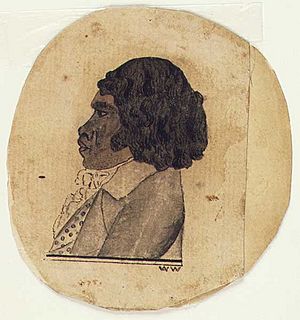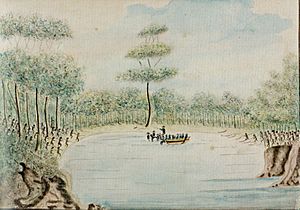Bennelong facts for kids
Quick facts for kids
Bennelong
|
|
|---|---|

Portrait (signed "W.W.") thought to depict Bennelong
|
|
| Born | c. 1764 |
| Died | 3 January 1813 |
| Other names | Baneelon |
| Spouse(s) | Barangaroo (d. 1791) |
| Children | Dicky Dicky |
Woollarawarre Bennelong (around 1764 – 3 January 1813), also known as Baneelon, was an important leader of the Eora people. The Eora are an Aboriginal Australian group from the Port Jackson area. This was where the first British settlers arrived in Australia in 1788. Bennelong helped the Eora and the British talk to each other. He did this both in the new colony of New South Wales and when he visited the United Kingdom.
| Top - 0-9 A B C D E F G H I J K L M N O P Q R S T U V W X Y Z |
Who Was Bennelong?
Bennelong was born around 1764. His parents were Goorah-Goorah and Gagolh. He belonged to the Wangal clan, which was connected to the south side of the Parramatta River. He also had strong ties to the Wallumedegal and Burramattagal clans.
Bennelong had several sisters: Wariwéar, Karangarang, Wûrrgan, and Munânguri. They married important men from other clans. This helped Bennelong build strong connections with nearby groups. He had five different names given to him during special ceremonies. One of his personal properties was Memel Island in Port Jackson, which he inherited from his father.
Bennelong had several wives. His first wife died, possibly from smallpox. He then married Barangaroo, a woman from the Cammeray clan. She passed away in 1791. Later, he was with a Gweagal woman named Kurubarabüla. When he returned from England, he had a son named Dicky with another woman. His last wife was Boorong, who was buried with him.
Captured by the British
In November 1789, Bennelong was brought to the British settlement at Sydney Cove. The governor, Arthur Phillip, had orders from King George III to make friends with the local Aboriginal people. At first, the Eora avoided the British. So, Governor Phillip decided to capture some Aboriginal men to learn their language and customs.
Another man named Arabanoo was captured earlier, but he died from a smallpox outbreak in May 1789. Bennelong and another man named Colebee were captured on 25 November 1789. William Bradley painted a picture of this event. He wrote in his journal that it was the 'most unpleasant service' he ever had to do.
At the time, Bennelong was about 25 years old. He was described as strong and brave. Colebee soon escaped, but Bennelong stayed in the settlement for several months. He then slipped away too.
The Spearing Incident
Four months later, Bennelong was seen by British officers in Manly Cove. Governor Phillip was told and wanted to meet him. Phillip had planned a whale feast to try and make friends with the Eora again. When Phillip approached Bennelong, who was with about 20 warriors, Bennelong pointed to another Aboriginal person, Willemering. Phillip thought this was an invitation to meet, so he offered his hand to Willemering.
However, Willemering responded by spearing Phillip in the shoulder. There was a brief fight, but officers quickly got the Governor to safety. Some historians believe Bennelong asked Willemering to spear Phillip. This might have been a form of "payback" for Bennelong being captured. It was a way to make things right before any further talks with the British. Phillip ordered that no one should get revenge. A few days later, Bennelong visited Phillip as he was getting better, and their friendship continued.
Bennelong kept good relations with the colony. He even gave Phillip an Aboriginal name, Wolawaree, as a sign of friendship. Bennelong also learned to speak English. In 1790, the governor built him a hut on what is now called Bennelong Point (where the Sydney Opera House stands today).
Trip to England
In 1792, Bennelong and another Aboriginal man named Yemmerrawanne traveled with Governor Phillip to England on a ship called the Atlantic. Many historians say they met King George III, but there is no clear proof. Soon after arriving, they were given clothes suitable for meeting the King.
Records show some of their activities in England. They visited St Paul's Cathedral and the Tower of London. They also went swimming and to the theatre. They stayed with Henry Waterhouse. When Yemmerrawanne became sick, they moved to Eltham and met Lord Sydney.
Sadly, Yemmerrawanne died in Britain from a chest infection. Bennelong's health also got worse. He returned to Sydney in February 1795 on HMS Reliance. The ship's surgeon, George Bass, helped Bennelong get better. In return, Bennelong taught Bass enough of the Dharuk language to talk with the Eora people in Sydney. Bennelong spent about 18 months of his nearly three years abroad on ships.
Back in New South Wales
Bennelong arrived back in Sydney on 7 September 1795. In 1796, he wrote a letter to Mr and Mrs Phillips, thanking Mrs Phillips for her care in England. This letter is the first known text written in English by an Indigenous Australian.
After returning, Bennelong often went back to living in the bush. He would only occasionally come to dine at the governor's house. Many British reports said he refused to rejoin "polite society." He often took part in traditional battles and led ceremonies. This included the last recorded initiation ceremony in Port Jackson in 1797. By the early 1800s, he was the leader of a clan of about 100 people. They lived on the north side of the river, near Kissing Point.
His Final Years
Bennelong died on 3 January 1813 at Kissing Point, near the Parramatta River in Sydney. He was buried in the orchard of his friend, James Squire, a brewer. The Sydney Gazette newspaper wrote a harsh notice about his death. It said he was "a thorough savage" who would not change. This showed how some white settlers felt as more land was taken for farms. It also showed the growing tension between the two groups.
Bennelong's people mourned his death with a traditional battle involving about 200 people. As a sign of deep respect, Colebee's nephew, Nanbaree, asked to be buried with Bennelong when he died in 1821. Bennelong's last wife, Boorong, was also buried in the same grave. Bidgee Bidgee, who led the Kissing Point clan after Bennelong, also wanted to be buried with him, but his burial place is unknown.
In 2011, Peter Mitchell of Macquarie University announced he had found Bennelong's grave site. It is under a house at 25 Watson Street, Putney, New South Wales. In 2018, the New South Wales Government bought the house. They plan to turn the site into a public memorial for Bennelong. It will also be a museum about the impact of British settlement on Aboriginal people in Sydney.
Bennelong's Legacy
For a long time, people had different ideas about Bennelong's importance. Some historians said he disappointed the British and was an outcast from his own people. But in recent years, he has been seen differently. Many now believe he understood both the good and bad parts of Western culture and chose to reject some of it.
Bennelong's friendships with the British helped other Indigenous people meet the Sydney Cove colonists. He played a key role in some of the first talks between the groups. This helped create a short time of peace between them.
- Bennelong Park is a small park near Kissing Point in Putney, Sydney. It is close to where Bennelong died.
- A small plaque in Cleves Park in Putney, Sydney, marks the area where his grave was thought to be.
- The Bennelong Bridge crosses Homebush Bay on the south side of the Parramatta River.
- The seat of Bennelong in the Federal parliament is named after him. This area includes Putney. Bennelong was the first Indigenous Australian to have an electoral area named after him.
- Bennelong Point, where the Sydney Opera House stands today, is named after him.
- A type of small crustacean, Bennelongia, was named after him in 1981. This animal is found only in Australia and New Zealand.
Portrayal in Media
Bennelong was played by actor Charles Yunupingu in the 1980 TV series The Timeless Land.
See also
In Spanish: Bennelong para niños


